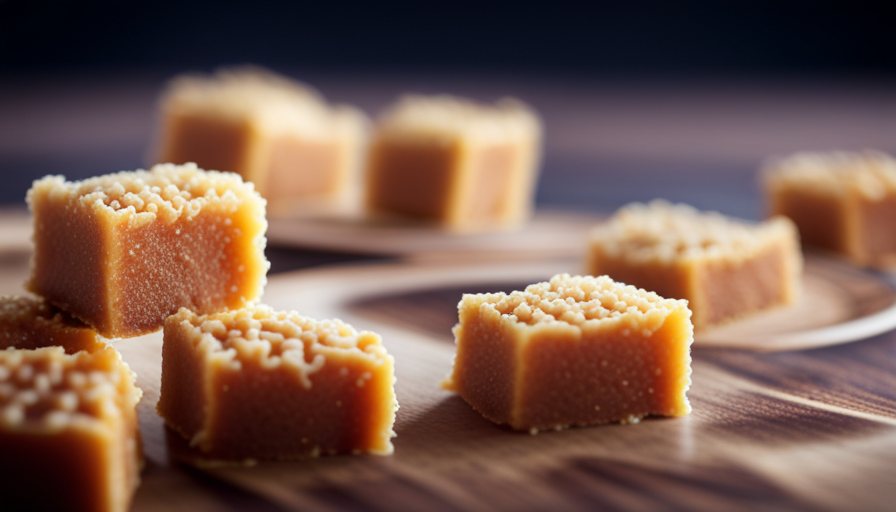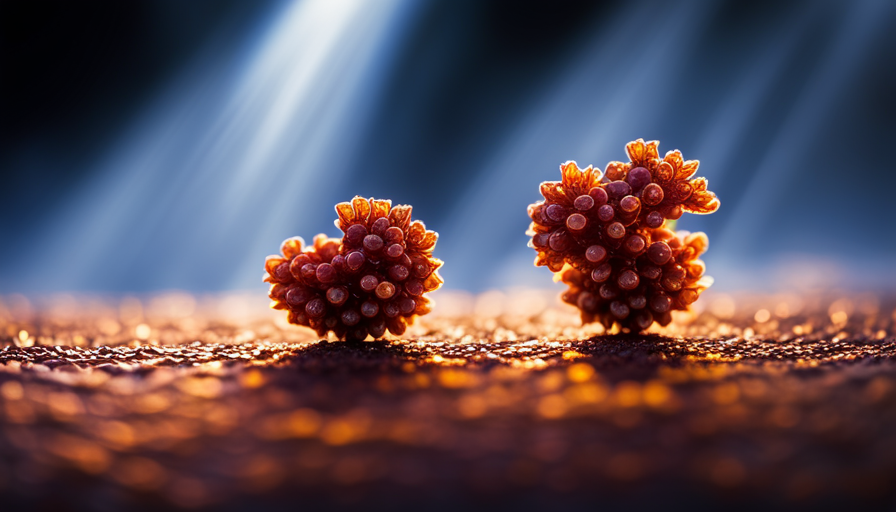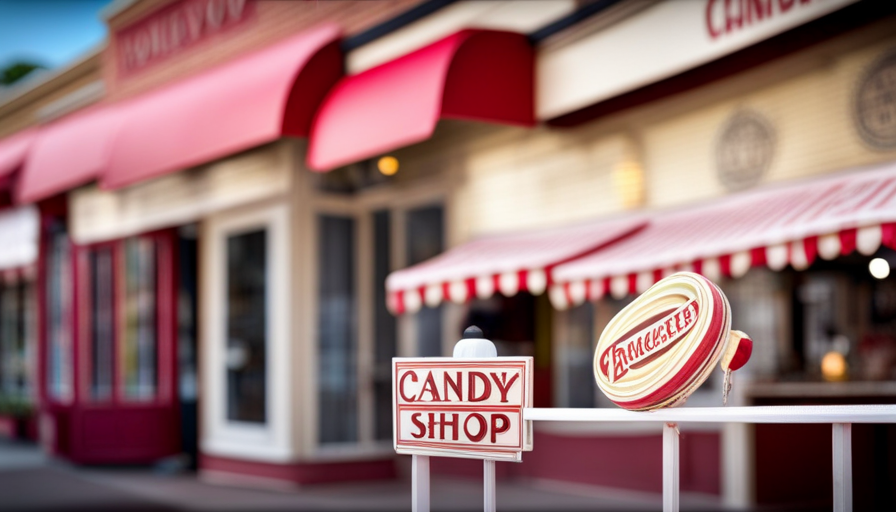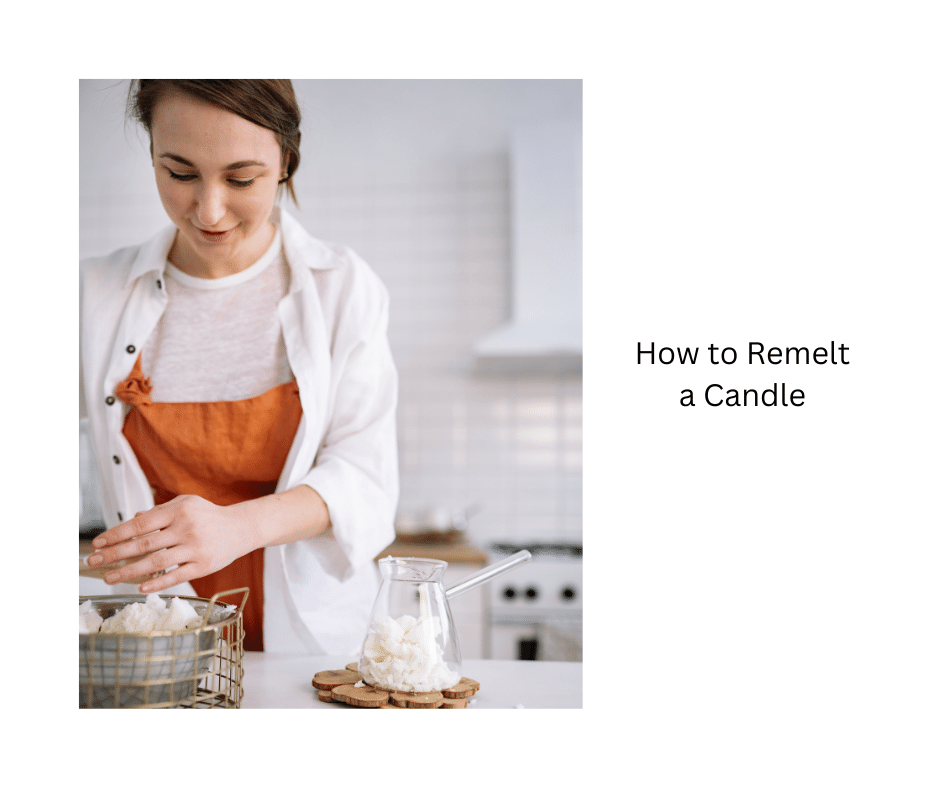Savoring a bite of this delightful treat, the subtle crunchiness releases a burst of flavors on my taste buds. It’s a simple pleasure that takes me back to my childhood, bringing back memories of carefree days.
Have you ever wondered what makes sponge candy so uniquely delicious? In this article, I will delve into the depths of this confectionary delight and explore what it is made of.
Sponge candy, also known as honeycomb toffee or seafoam candy, is a melt-in-your-mouth treat that is beloved by many. Its light and airy texture is a result of a fascinating chemical reaction that occurs during its creation.
The main ingredients used in making sponge candy are sugar, corn syrup, and baking soda. These ingredients, when combined and heated, undergo a process known as caramelization, resulting in the formation of countless tiny air bubbles trapped within the candy.
In the following sections, I will guide you through the history, ingredients, process, and even some tips for making perfect sponge candy at home. So, get ready to satisfy your sweet tooth and uncover the secrets behind this delightful confection.
Key Takeaways
- Sponge candy is made from sugar, corn syrup, and baking soda.
- The cooking process involves caramelization of the ingredients to create countless tiny air bubbles.
- Timing and temperature control are crucial in the process to achieve the perfect texture.
- There are various flavor variations of sponge candy, including classic options like vanilla and chocolate, as well as unique choices like mint or peanut butter.
The History of Sponge Candy
Did you know that the history of sponge candy is as fascinating as its delectable taste? This sweet treat has a long and rich history, with its origins dating back to the early 19th century.
Sponge candy, also known as honeycomb toffee or sea foam candy, has deep cultural significance in various regions around the world. The exact origin of sponge candy is uncertain, but it is believed to have originated in Europe. It was brought to America by immigrants who settled in cities such as Buffalo, New York, where it gained popularity. In fact, Buffalo is often referred to as the ‘sponge candy capital of the world,’ owing to its strong association with this confection.
Sponge candy is not only beloved for its taste, but also for the memories and traditions it carries. It is often associated with holidays and special occasions, and has become a staple in many cultural celebrations. Its unique texture and sweet flavor make it a favorite among people of all ages.
Now, let’s dive into the ingredients used in sponge candy and discover how this delectable treat is crafted.
Ingredients Used in Sponge Candy
One of the key components of sponge candy is a delicate honeycomb-like structure formed by a reaction between baking soda and hot sugar syrup, which gives it its distinctive airy texture. The ingredients used to make sponge candy are relatively simple, but their combination and cooking techniques are what create its unique flavor profiles.
Here is a table that outlines the main ingredients used in sponge candy and their purpose:
| Ingredient | Purpose |
|---|---|
| Sugar | Provides sweetness and structure |
| Corn syrup | Helps prevent crystallization |
| Baking soda | Reacts with hot syrup, creating bubbles and light texture |
| Vinegar | Activates the baking soda reaction |
| Chocolate | Coating for added flavor and texture |
The cooking process involves heating the sugar, corn syrup, and vinegar together until they reach a specific temperature. Then, the baking soda is added, causing a chemical reaction that creates the signature sponge-like structure. The mixture is poured into molds to cool and set. Lastly, the sponge candy is coated in chocolate, adding another layer of flavor and texture.
Transitioning into the subsequent section about the process of making sponge candy, it is fascinating to see how a few simple ingredients and precise cooking techniques can create such a unique and delicious treat.
The Process of Making Sponge Candy
When making sponge candy, it’s crucial to follow a step-by-step guide to achieve the desired result. Timing and temperature are also crucial considerations in the process.
By carefully controlling the temperature and timing, I can ensure that the sugar mixture reaches the right consistency and the candy sets properly.
Step-by-step guide
To make sponge candy, you’ll need to start by combining sugar, corn syrup, and vinegar in a saucepan. Heat the mixture over medium-high heat until it reaches a temperature of 300 degrees Fahrenheit.
Once the mixture has reached the desired temperature, remove it from the heat and quickly stir in baking soda. The mixture will froth up and become light and airy.
Pour the mixture into sponge candy molds, allowing it to cool and harden for about 30 minutes. After the candy has set, remove it from the molds and prepare for the dipping process.
There are different dipping techniques you can use, such as fully immersing the candy in melted chocolate or partially dipping it for a decorative effect. Once the candy has been dipped, allow it to cool and harden completely.
Temperature and timing considerations are crucial to achieving the perfect texture and consistency of sponge candy. Transitioning into the subsequent section, it’s important to carefully monitor the temperature and timing to ensure the candy sets properly.
Temperature and timing considerations
Navigating the fiery dance of temperatures and the delicate balance of timing is the key to unlocking the ethereal essence of sponge candy.
Temperature control is crucial in the caramelization process, where sugar undergoes a complex transformation. The first step involves heating sugar and corn syrup to a specific temperature, usually around 310°F (154°C). This ensures that the sugar caramelizes properly, creating the rich, golden color and distinct flavor of the candy.
Once the desired temperature is reached, the mixture is quickly poured over baking soda, causing a chemical reaction that transforms the syrupy mixture into a light and airy sponge-like structure.
Timing is essential during this process, as pouring the hot caramel at the right moment allows the bubbles to form and create the unique texture of sponge candy.
Understanding the science behind its texture is the next fascinating aspect to explore.
The Science Behind Its Texture
Imagine sinking your teeth into a crispy, golden piece of sponge candy, made from a delicate combination of sugar, corn syrup, and baking soda. The unique texture of sponge candy is a result of the chemical reactions that occur during the candy making process. Sugar plays a crucial role in creating the sponge-like texture of this delectable treat.
When sugar is heated to a specific temperature, it undergoes a process called caramelization. During this process, the sugar molecules break down and form new compounds, resulting in a rich and complex flavor. Additionally, the high temperature causes the sugar to melt and combine with the other ingredients, creating a sticky syrup.
The addition of baking soda is what gives sponge candy its light and airy texture. When baking soda is mixed into the hot sugar syrup, it undergoes a chemical reaction known as thermal decomposition. This reaction produces carbon dioxide gas, which gets trapped within the candy, creating air pockets and giving it a sponge-like consistency.
As we delve into the subsequent section about the flavor variations of sponge candy, it’s important to note the crucial role that sugar and the chemical reactions involved play in creating its unique texture.
Flavor Variations of Sponge Candy
When it comes to flavor variations of sponge candy, there are a wide range of different flavorings that can be used. From classic options like vanilla and chocolate to more unique choices such as mint or peanut butter, the possibilities are endless.
What makes it even more exciting is the opportunity to create creative combinations, like salted caramel or raspberry cheesecake, that take this beloved treat to a whole new level of deliciousness.
Different flavorings used
To truly appreciate sponge candy, you need to try the different flavorings used, like the delightful burst of cherry or the rich indulgence of dark chocolate. The flavorings used in sponge candy are carefully selected to create a harmonious pairing that enhances the overall taste experience. Here are some flavor pairing suggestions that you can explore:
| Flavor | Description |
|---|---|
| Cherry | A sweet and tangy flavor that adds a refreshing twist |
| Dark Chocolate | A bold and intense flavor that complements the sweetness |
| Coffee | A rich and robust flavor that adds a subtle bitterness |
| Mint | A cool and refreshing flavor that adds a hint of freshness |
| Peanut Butter | A creamy and nutty flavor that adds depth to the candy |
These unique flavor experiments take sponge candy to new heights, pushing the boundaries of taste and imagination. With such a wide array of flavor options, the possibilities for creative combinations are endless.
Creative combinations
The creative combinations of different flavorings in sponge candy take your taste buds on a flavorful journey, tantalizing your senses with unexpected and delightful pairings.
Here are five unique flavor combinations that’ll leave you craving for more:
-
Dark chocolate and sea salt: The rich bitterness of dark chocolate perfectly balances the savory saltiness of sea salt, creating a harmonious blend of flavors.
-
Maple and bacon: The sweet and smoky flavors of maple syrup and crispy bacon create a unique taste experience that’s both comforting and indulgent.
-
Espresso and caramel: The boldness of espresso complements the sweetness of caramel, resulting in a sophisticated and decadent combination.
-
Raspberry and white chocolate: The tartness of raspberries cuts through the sweetness of white chocolate, creating a refreshing and fruity treat.
-
Matcha and coconut: The earthy notes of matcha green tea are enhanced by the tropical sweetness of coconut, offering a unique and exotic flavor profile.
These creative flavor combinations not only elevate the taste of sponge candy but also provide unique serving suggestions, such as crumbling it over ice cream or using it as a topping for cakes and desserts.
Now, let’s explore the regional variations of sponge candy.
Regional Variations of Sponge Candy
While there are various regional variations of sponge candy, the common ingredients include sugar, corn syrup, baking soda, and chocolate. Regional preferences and cultural significance play a significant role in the different ways sponge candy is made around the world. Here is a table showcasing three regional variations:
| Region | Ingredients | Notable Characteristics |
|---|---|---|
| Buffalo, NY | Dark corn syrup, white sugar, vinegar | Light and airy texture, often coated in milk chocolate |
| Western New York | Honey, brown sugar, baking powder | Crunchy texture, usually coated in dark chocolate |
| Australia | Golden syrup, sugar, bicarbonate of soda | Honeycomb-like texture, often coated in milk chocolate |
In Buffalo, NY, sponge candy holds a special place in the hearts of locals. It is a beloved treat during holidays and festivals, and residents often prefer the classic milk chocolate coating. On the other hand, Western New York has its own twist, using honey and brown sugar to create a unique flavor profile with a dark chocolate coating. In Australia, sponge candy, also known as honeycomb toffee, is popular and enjoyed with a milk chocolate coating. The use of golden syrup gives it a distinct taste and texture.
Mastering the art of making perfect sponge candy at home requires precision and attention to detail. With the right ingredients and technique, you can create a delectable treat that will impress your friends and family. Transitioning to the next section, let’s explore some tips for achieving sponge candy perfection in your own kitchen.
Tips for Making Perfect Sponge Candy at Home
When making sponge candy at home, it’s important to have the proper equipment and tools to ensure success. Some essential items include a candy thermometer, a heavy-bottomed saucepan, a whisk or wooden spoon, and a silicone baking mat or parchment paper.
Additionally, it’s crucial to avoid common mistakes such as overheating the sugar syrup, not using the correct ratios of ingredients, and not allowing enough time for the candy to cool and set properly.
Equipment and tools needed
To make sponge candy, you’ll need equipment and tools like a candy thermometer, a saucepan, and a whisk. Sponge candy molds and candy thermometers are essential for achieving the perfect texture and consistency. The candy thermometer helps ensure that the sugar mixture reaches the correct temperature, while the saucepan allows for even heat distribution during the cooking process. A whisk is necessary for stirring the ingredients together and creating air bubbles that give sponge candy its characteristic light and airy texture.
In order to evoke an emotional response in the audience, I have prepared a table that showcases the tools and their importance in the sponge candy making process:
| Tool | Importance |
|---|---|
| Candy thermometer | Ensures the sugar mixture reaches the correct temperature |
| Saucepan | Provides even heat distribution during the cooking process |
| Whisk | Helps create air bubbles for the light and airy texture |
| Sponge candy molds | Give the candy its distinct shape and allow it to set properly |
| Oven mitts | Protect your hands from the hot surfaces and prevent burns |
Now that we have the necessary equipment and tools, let’s move on to the next section about common mistakes to avoid when making sponge candy.
Common mistakes to avoid
One crucial aspect to creating the perfect batch of sponge candy is being mindful of common mistakes to avoid. To ensure success, here are some troubleshooting tips to keep in mind:
-
Overheating the sugar syrup: This can result in a hard, brittle texture instead of the desired light and airy consistency. Be sure to closely monitor the temperature and remove the syrup from the heat at the right moment.
-
Incorrect candy temperature: If the candy mixture isn’t heated to the proper temperature, it may not set correctly or become too sticky. Use a candy thermometer to accurately monitor the temperature throughout the process.
These mistakes can easily be avoided by following a precise recipe and paying close attention to the details. By being aware of these common pitfalls, you can create a batch of sponge candy that’s sure to impress.
In the next section, we’ll explore popular brands and shops that sell sponge candy.
Popular Brands and Shops That Sell Sponge Candy
There are numerous well-known brands and shops where you can find delicious sponge candy. These popular shops offer a wide variety of unique flavors that will surely satisfy any sweet tooth.
One such brand is ‘Sponge Delights,’ which has gained a reputation for its high-quality sponge candy. They offer flavors like classic milk chocolate, dark chocolate, and even exotic flavors such as salted caramel and raspberry.
Another popular brand is ‘Sweet Treats,’ known for their innovative flavors like peanut butter and jelly, mint chocolate chip, and cookies and cream.
If you’re looking for a local shop to indulge in this delectable treat, ‘Candy Haven’ is a must-visit. They offer a wide selection of sponge candy flavors, including seasonal options like pumpkin spice and peppermint during the holidays.
Additionally, ‘The Candy Emporium’ is another favorite among sponge candy enthusiasts, with its vast assortment of flavors and textures.
Transitioning into the subsequent section about creative uses for sponge candy, it’s important to note that these popular brands and shops not only provide ready-to-eat sponge candy but also inspire us to explore its versatility in various culinary creations.
Creative Uses for Sponge Candy
Who would have thought that something as seemingly simple as a sweet, crunchy treat could be transformed into a culinary masterpiece? Sponge candy desserts offer a delightful twist on the classic confection, taking it to new heights of deliciousness.
Here are some creative uses for sponge candy that will leave your taste buds craving more:
-
Ice Cream Topping: Crumble sponge candy over a scoop of your favorite ice cream flavor for an added crunch and a burst of sweetness.
-
Cake Decoration: Sprinkle crushed sponge candy on top of cakes or cupcakes to add a unique texture and a touch of elegance.
-
Hot Chocolate Stirrer: Dip a piece of sponge candy into a steaming mug of hot chocolate and use it as a stirrer. As it melts, it infuses the drink with a rich, caramel flavor.
-
Gift Basket Filler: When putting together a gift basket, include some sponge candy for a delightful surprise. Its distinct texture and taste make it a perfect addition to any gift.
These sponge candy desserts and unique gift ideas demonstrate the versatility of this delectable treat. So, don’t limit yourself to just enjoying it as is. Get creative and explore the many possibilities that sponge candy has to offer.
As we reach the conclusion and final thoughts on sponge candy, let’s delve into its cultural significance and why it continues to be a beloved treat for many.
Conclusion and Final Thoughts on Sponge Candy
After exploring the creative uses for sponge candy, it’s clear that this confectionery is truly versatile and can be enjoyed in various ways. Now, let’s delve into the final topic of discussion and draw some conclusions about sponge candy.
Sponge candy has gained popularity as a confectionery treat, and for good reason. Its unique texture, which is light and airy on the inside while crunchy on the outside, sets it apart from other similar candies. This contrast in textures makes each bite a delightful experience for the taste buds.
When comparing sponge candy to other similar candies, it’s important to note that its distinct texture and flavor make it stand out. Unlike toffee or caramel, which have a chewier consistency, sponge candy melts in your mouth, leaving a sweet and caramelized taste. Additionally, sponge candy is often coated in chocolate, adding another layer of richness to the overall flavor profile.
Sponge candy is a popular confectionery that offers a one-of-a-kind texture and taste. Its light and airy interior, combined with the crunchy exterior, creates a unique sensory experience. When compared to other similar candies, sponge candy’s melt-in-your-mouth consistency and chocolate coating make it a standout choice.
Whether enjoyed on its own or used in various creative ways, sponge candy is sure to satisfy any sweet tooth.
Frequently Asked Questions
How long does sponge candy last before it goes bad?
The shelf life of sponge candy varies depending on how it’s stored. When stored in an airtight container at room temperature, it can last for up to two weeks. However, if exposed to moisture or humidity, it can become sticky and lose its crispness. It’s important to keep sponge candy in a cool, dry place to maintain its quality. Proper storage recommendations ensure that the candy stays fresh and delicious for as long as possible.
Can sponge candy be made without using corn syrup?
Yes, sponge candy can be made without using corn syrup. There are alternative sweeteners that can be used in homemade recipes, such as honey or maple syrup. These sweeteners can provide a similar consistency and flavor to corn syrup.
When making sponge candy without corn syrup, it’s important to adjust the recipe accordingly to ensure the proper texture and taste.
Is sponge candy safe for individuals with nut allergies?
As someone with knowledge of allergen labeling and safety measures for sponge candy, I can confidently say that nut-free alternatives for sponge candy do exist. These alternatives are made without any nuts or nut-derived ingredients, ensuring that individuals with nut allergies can safely enjoy sponge candy.
Additionally, reputable manufacturers understand the importance of clearly labeling their products for allergens, including nuts, to help consumers make informed choices. Therefore, individuals with nut allergies can find safe options and enjoy the delightful treat of sponge candy.
Can sponge candy be made using alternative sweeteners, such as honey or agave?
I’ve explored the possibility of using alternative sweeteners like honey or agave in making sponge candy. While these options can add unique flavors, there are pros and cons to consider.
Honey brings a rich and floral taste, but can affect the candy’s texture. Agave syrup offers a smooth and mellow sweetness, but may alter the final consistency.
Experimenting with different flavors in sponge candy can be exciting, but it’s important to carefully balance taste and texture.
Are there any health benefits or nutritional value associated with consuming sponge candy?
There aren’t any significant health benefits or nutritional value associated with consuming sponge candy. In fact, it’s important to note that sponge candy is high in sugar and calories, which can contribute to weight gain and increased risk of health problems such as obesity, diabetes, and tooth decay.
Additionally, excessive consumption of sugary foods like sponge candy can lead to potential side effects including energy crashes, mood swings, and an increased risk of developing chronic diseases.
Conclusion
In conclusion, sponge candy is a delectable treat that has captured the hearts and taste buds of many. It’s made with a combination of sugar, corn syrup, and baking soda, giving it a unique texture that sets it apart from other candies. This confection is both sweet and airy, thanks to a meticulous process. Its versatility allows for various flavor variations, ensuring there’s something to please everyone’s palate. Whether enjoyed on its own or incorporated into other desserts, sponge candy is sure to leave a lasting impression. Its irresistible charm is enough to make your taste buds dance with joy.









